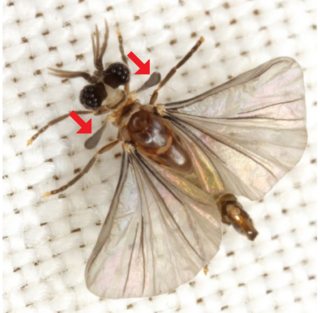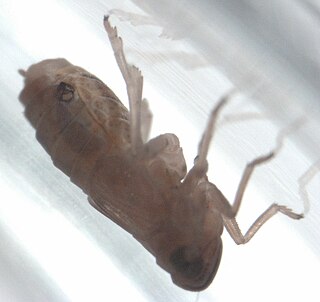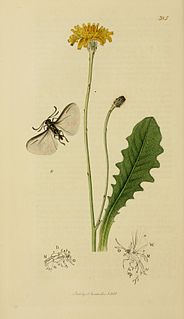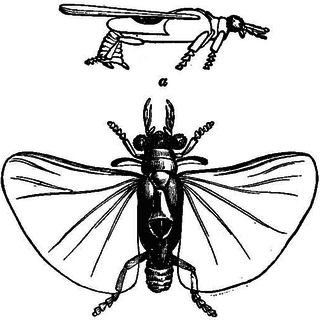 W
WThe Strepsiptera are an endopterygote order of insects with nine extant families that include about 600 described species. They are endoparasites in other insects, such as bees, wasps, leafhoppers, silverfish, and cockroaches. Females of most species never emerge from the host after entering its body, finally dying inside it. The early-stage larvae do emerge because they must find an unoccupied living host, and the short-lived males must emerge to seek a receptive female in her host. They are believed to be most closely related to beetles, from which they diverged 300–350 million years ago, but do not appear in the fossil record until the Mid-Cretaceous around 100 million years ago.
 W
WCaenocholax is a genus of twisted-winged insects in the family Myrmecolacidae. There are about nine described species in Caenocholax.
 W
WCaenocholax fenyesi is a species of twisted-winged parasitic insects in the order Strepsiptera and family Myrmecolacidae. It has a sporadic distribution throughout North America, Central America, and South America. Chaenochlax brasiliensis is the only other named species in the genus.
 W
WThe Corioxenidae are an insect family of the order Strepsiptera. Species in this family are parasites of heteropteran bugs including the Pentatomidae, Scutelleridae, Cydnidae, Coreidae, and Lygaeidae. The males lack mandibles. Three subfamilies within this family are recognized. The subfamilies are separated using morphology of the males, particularly on the basis of the number of tarsi and the presence of tarsal claws.Corioxeninae Kinzelbach, 1970 Corioxenos Blair, 1936 Floridoxenos Kathirithamby and Peck, 1994 Loania Kinzelbach, 1970 Perissozocera Johnson, 1976 Australoxenos Kathirithamby, 1990 Blissoxenos Miyamoto & Kifune, 1984 Malayaxenos Kifune, 1981 Mufagaa Kinzelbach, 1980 Viridipromontorius Luna de Carvalho, 1985 Triozocerinae Kinzelbach, 1970 Triozocera Pierce, 1909 Dundoxenos Luna de Carvalho, 1956 Uniclavinae Kathirithamby, 1989 Uniclavus Kathirithamby, 1989 Proceroxenos Pohl, Katbeh-Bader & Schneider, 1996
 W
WThe Elenchidae are an insect family in the order Strepsiptera.
 W
WElenchus is an insect genus in the family Elenchidae.
 W
WElenchus koebelei is an insect species in the genus Elenchus.
 W
WElenchus maorianus is a parasitic insect species in the genus Elenchus found in New Zealand.
 W
WElenchus tenuicornis is an insect species in the genus Elenchus.
 W
WHalictophagidae are an insect family of the order Strepsiptera.
 W
WHalictophagus is a genus of insects in the family Halictophagidae.
 W
WMengenillidae is a family of insects belonging to the order Strepsiptera.
 W
WMyrmecolacidae is an insect family of the order Strepsiptera. There are four genera and about 98 species in this family. Like all strepsipterans, they have a parasitic mode of development with males parasitizing ants while the females develop inside Orthoptera. The sexes differ greatly in morphology making it very difficult to match females to the better catalogued museum specimens of males.
 W
WStylopidae is a family of twisted-winged insects in the order Strepsiptera. There are about 15 genera and more than 330 described species in Stylopidae.
 W
WStylops is a genus of obligately endoparasitic insects in the family Stylopidae. Hosts are typically members of the order Hymenoptera. The official seal, and later logo, of the Royal Entomological Society features a male Stylops.
 W
WStylops melittae is a species of the order Strepsiptera of flying insects, that parasitize various species of sand bees (Andrena).
 W
WXenos is a genus of insects belonging to the family Stylopidae. The word derives from the Greek word for strange. A species of the genus is Xenos vesparum, first described by Pietro Rossi in 1793. The females are permanent entomophagous endoparasites of Polistes paper wasps. They dwell their whole lives in the abdomens of wasps.
 W
WXenos vesparum is a parasitic insect species of the order Strepsiptera that are endoparasites of paper wasps in the genus Polistes that was first described in 1793. Like other members of this family, X. vesparum displays a peculiar lifestyle, and demonstrates extensive sexual dimorphism.